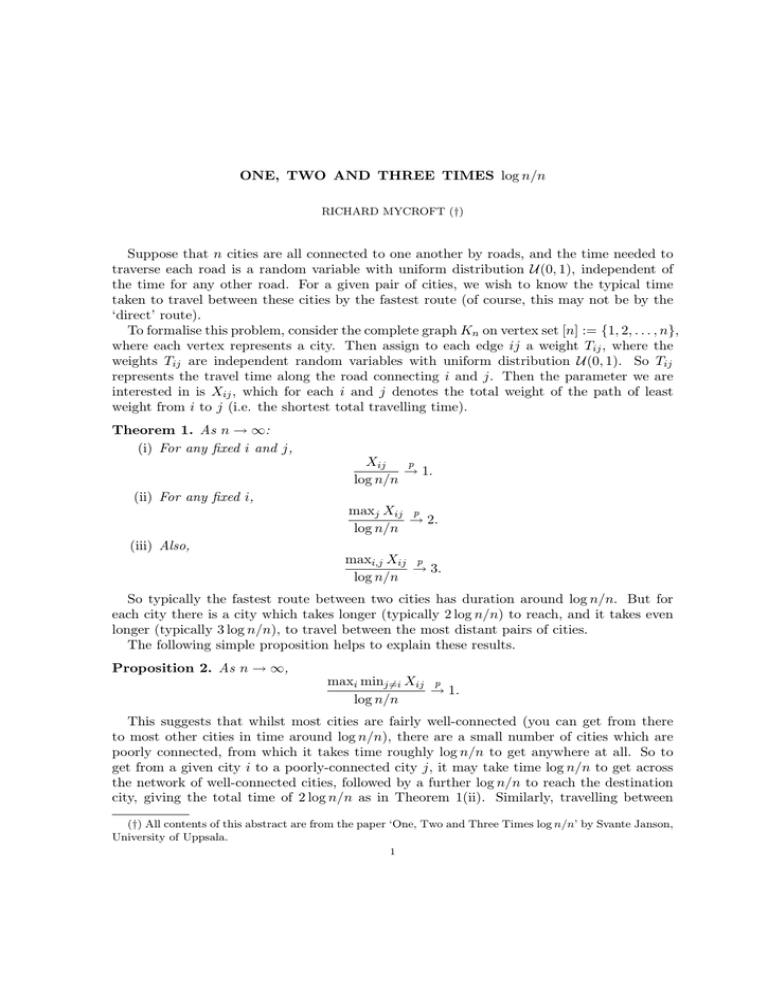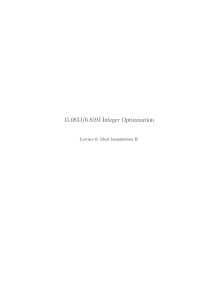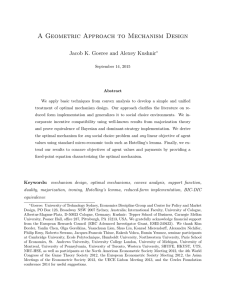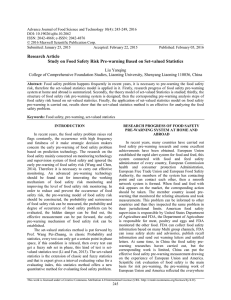ONE, TWO AND THREE TIMES log n/n
advertisement

ONE, TWO AND THREE TIMES log n/n
RICHARD MYCROFT (†)
Suppose that n cities are all connected to one another by roads, and the time needed to
traverse each road is a random variable with uniform distribution U(0, 1), independent of
the time for any other road. For a given pair of cities, we wish to know the typical time
taken to travel between these cities by the fastest route (of course, this may not be by the
‘direct’ route).
To formalise this problem, consider the complete graph Kn on vertex set [n] := {1, 2, . . . , n},
where each vertex represents a city. Then assign to each edge ij a weight Tij , where the
weights Tij are independent random variables with uniform distribution U(0, 1). So Tij
represents the travel time along the road connecting i and j. Then the parameter we are
interested in is Xij , which for each i and j denotes the total weight of the path of least
weight from i to j (i.e. the shortest total travelling time).
Theorem 1. As n → ∞:
(i) For any fixed i and j,
Xij
p
→ 1.
log n/n
(ii) For any fixed i,
maxj Xij p
→ 2.
log n/n
(iii) Also,
maxi,j Xij p
→ 3.
log n/n
So typically the fastest route between two cities has duration around log n/n. But for
each city there is a city which takes longer (typically 2 log n/n) to reach, and it takes even
longer (typically 3 log n/n), to travel between the most distant pairs of cities.
The following simple proposition helps to explain these results.
Proposition 2. As n → ∞,
maxi minj6=i Xij p
→ 1.
log n/n
This suggests that whilst most cities are fairly well-connected (you can get from there
to most other cities in time around log n/n), there are a small number of cities which are
poorly connected, from which it takes time roughly log n/n to get anywhere at all. So to
get from a given city i to a poorly-connected city j, it may take time log n/n to get across
the network of well-connected cities, followed by a further log n/n to reach the destination
city, giving the total time of 2 log n/n as in Theorem 1(ii). Similarly, travelling between
(†) All contents of this abstract are from the paper ‘One, Two and Three Times log n/n’ by Svante Janson,
University of Uppsala.
1
2
RICHARD MYCROFT (†)
two poorly-connected cities may take three steps, each of time log n/n, for a total time of
3 log n/n as in Theorem 1(iii).
The following standard coupling result both generalises Theorem 1 and is essential to its
proof.
Proposition 3. Let D be a non-negative probability distribution with P(D ≤ t) = t + o(t) as
t → 0. Then the validity of Theorem 1 is not affected if the independent random variables
Tij instead have distribution D (rather than being uniformly distributed).
By Proposition 3, we may assume that the random variables Tij have the exponential
distribution Exp(1) (so P(Tij ≤ t) = (1 − e−t ) = t + o(t) as t → 0). This will be very useful
in proving Theorem 1, due to the memoryless property of the exponential distribution.
Fact 4 (Memoryless propery of the exponential distribution). Let X ∼ Exp(λ). Then for
any s and t:
P(X > s + t|X > s) = P(X > t).
So to prove Theorem 1(i) and (ii), we consider the problem as a first-passage percolation
viewpoint. A good way to think of this is that a disease breaks out in city i, and spreads
along each edge after a Exp(1)-distributed waiting time (from the moment that one endvertex is infected). Then Xij is the time until city j is infected, and maxj Xij is the time
until all cities are infected. The fact that the waiting times are exponentially distributed
means that the typical values of these times can be calculated without too much difficulty.
Furthermore, the observation that P(maxi,j Xij ≥ a log n/n) ≤ nP(maxj Xij ≥ a log n/n)
(by symmetry) allows us to obtain an upper bound for Theorem 1(iii) fairly simply using
the same approach, since the right hand side of this inequality is amenable to a percolation
approach (for the left hand side, where would the disease start?). However, the proof of the
lower bound of Theorem 1(iii) is longer and more technical.
Janson goes on to consider the asymptotic distributions of Xij and maxj Xij , which are
not normal, and also the length of the path of minimal weight, but I do not expect to have
time to cover these topics.






